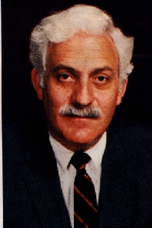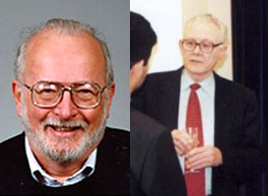The History of NMR
- In the beginning
- Toward biological NMR
- Inklings of MRI
- Breakthrough to MRI
- Commercialisation & dissemination
- A prize and a controversy
MRI is a relatively new imaging technique, having been in use in hospitals for around 25 years. However, NMR has a much longer pedigree.

Left to Right: Bloch, Purcell and Rabi
The NMR phenomenon was predicted in the early part of the twentieth century on the basis of the quantum theory of the atomic nucleus. Key dates are as follows
1936 – NMR predicted and searched for by the Dutch physicist Cornelius Gorter
The experiment failed only because Gorter’s equipment was insufficiently sensitive.
1937 – NMR observed in molecular beams by Isidor Rabi
Rabi was assisted by Gorter, and received the Nobel Prize for Physics in 1944 for this work.
1946 – NMR observed in liquids and solids by Bloch and Purcell
Bloch and Purcell made this discovery independently at Stanford and Harvard, respectively. They were jointly awarded the Nobel Prize for Physics in 1952 for this work.

Raymond Damadian
1971 – Raymond Damadian discovered difference between NMR signals from normal and cancerous tissues taken from in rats.
Damadian filed a US patent for an NMR machine to ‘scan’ the body in order to diagnose cancer. The patent did not specify precisely how the machine would work, or whether images could be produced.
Nevertheless, Damadian later enforced this patent against medical equipment manufacturers who had started to market MRI scanners. The settled with most companies, but General Electric fought him all the way to the US Supreme Court. Damadian won and was awarded $129 million in damages in 1997. The money was invested in Damadian’s company, Fonar, which still designs and sells innovative MRI systems.

L-R: Paul Lauterbur, Sir Peter Mansfield
1973 – Paul Lauterbur demonstrated MRI using magnetic field gradients (see below) in a seminar paper in Nature
1974 – Peter Mansfield (University of Nottingham) produced the first human MR images, of a finger.
1977 – Damadian obtained the first MRI body images
1978 – Ian Young (Hammersmith Hospital) produces the first MRI head images
1980 – John Mallard (University of Aberdeen) develops ‘spin-warp imaging’, the imaging method in widespread use today
It will be noted that many of these early developments took place in UK universities and hospitals, although for financial reasons MRI was slow to become established clinically in the UK as compared to the USA and other countries.
Major medical equipment manufacturers realised the potential of MRI in the early 1980s and began major investment. Although some of the early pioneers had established ‘spin out’ companies, with the exception of Damadian’s Fonar Corporation, these were unable to compete and today companies such as Philips, Siemens and General Electric dominate the market.
1988 – There were about 1,300 MRI systems worldwide (including one at Guy’s, installed in 1986)
2002 – There were about 22,000 MRI systems wordwide, performing 60 million examinations a year.
In the UK there are about 500 MRI scanners, performing over 1 million examinations a year. MRI is no longer the preserve of major university hospitals!
2003 – The Nobel Prize for Medicine was awarded to Mansfield and Lauterbur.
Here is part of the Nobel citation:
In the beginning of the 1970s, they made seminal discoveries concerning the development of the technique to visualise different structures. These findings provided the basis for the development of magnetic resonance into a useful imaging method.
In reaction to this, a group representing Damadian took out whole-page advertisements in the The New York Times, The Washington Post, and The Los Angeles Times protesting that he had been excluded from the prize award. This was the culmination of a priority dispute over the invention of MRI that had been going on for some years.
But the citation was written carefully to stress that the prize was being given for development of a useful imaging method.